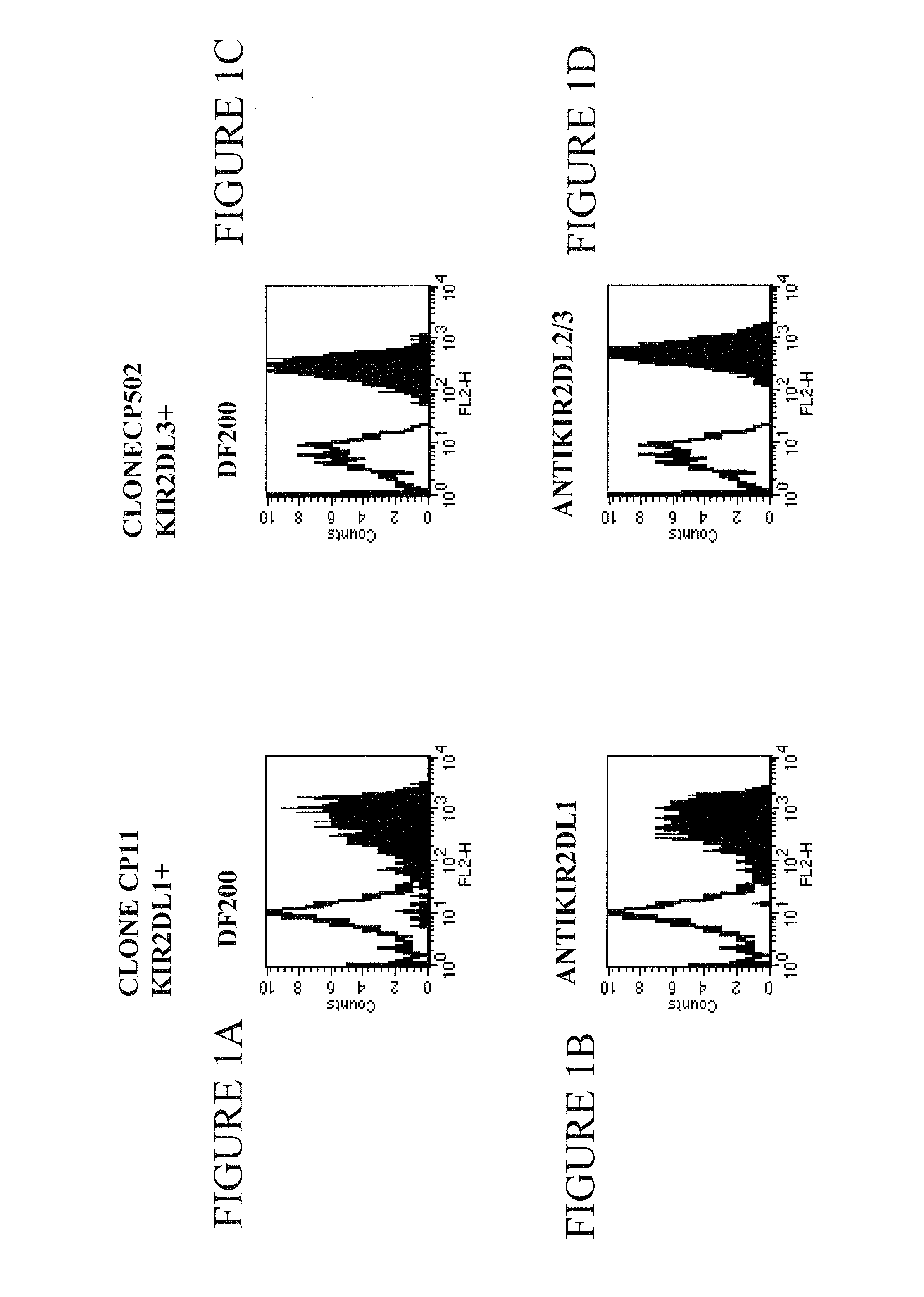Methods and Compositions for Increasing the Efficiency of Therapeutic Antibodies Using NK Cell Potentiating Compounds
a technology of nk cell potentiating compounds and compositions, which is applied in the field of methods and compositions for increasing the efficiency of therapeutic antibodies, can solve the problems of inability to show strong efficacy, inability to use therapeutic antibodies, and inability to fully understand the actual causes of treatment failure, so as to enhance the ability of nk cells to deplete the target cells, enhance the ability of therapeutic antibodies to destroy, and improve the effect of treatment efficiency
- Summary
- Abstract
- Description
- Claims
- Application Information
AI Technical Summary
Benefits of technology
Problems solved by technology
Method used
Image
Examples
example 1
Generation of a Pan KIR2DL Antibody
[0126]Purification of PBLs and Generation of Polyclonal or Clonal NK Cell Lines
[0127]PBLs were derived from healthy donors by Ficoll Hypaque gradients and depletion of plastic adherent cells. To obtain enriched NK cells, PBLs were incubated with anti CD3, anti CD4 and anti HLA-DR mAbs (30 mns at 4° C.), followed by goat anti mouse magnetic beads (Dynal) (30 mns at 4° C.) and immunomagnetic selection by methods known in the art (Pende et al., 1999). CD3 minus, CD4 minus DR minus cells are cultivated on irradiated feeder cells and 100 U / ml Interleukin 2 (Proleukin, Chiron Corporation) and 1.5 ng / ml Phytohemagglutinin A (Gibco BRL) to obtain polyclonal NK cell populations. NK cell are cloned by limiting dilution and clones of NK cells are characterized by flow cytometry for expression of cell surface receptors.
[0128]The following clones were used in this study:
[0129]CP11, CN5 and CN505 are KIR2DL1 positive clones and are stained by EB6 or XA-141 antib...
example 2
Enhancement of ADCC by Using a Combination of Rituxan and Anti KIR mAb
[0156]Preparation of human NK clones. Blood mononuclear cells depleted of T cells by negative anti-CD3 immuno-magnetic selection (Miltenyi) are plated under limiting-dilution conditions, activated with phytohemagglutinin (PHA) (Biochrom KG, Berlin, Germany), and cultured with interleukin (IL)-2 (Chiron B.V., Amsterdam, Netherlands) and irradiated feeder cells. Cloning efficiencies are equivalent in all donors and range between 1 in 5 and 1 in 10 plated NK cells. Cloned NK cells are screened for alloreactivity by standard 51Cr release cytotoxicity against Epstein-Barr virus-transformed B lymphoblastoid cell lines of known HLA type at an effector to target ratio of 10:1. Clones exhibiting ≧30% lysis were scored as alloreactive. As a rule, clones either exhibit 40% lysis.
[0157]Enhancement of ADCC Mediated by Rituxan by a KIR2DL1 Positive NK Cell Clone
[0158]The cytolytic activity of NK clone is assessed by a standard ...
example 3
Enhancement of ADCC Mediated by Capath by a KIR2DL1 Positive NK Cell Clone
[0160]In a similar experiment to that described in Example 2, autologous Cw4+ PHA blasts were incubated in the presence of NK cells plus alumtuzumab (Campath, Berlex), the EB6 antibody (at 100 ug / ml), or Campath and EB6. The results, shown in FIG. 4, show that the presence of EB6 dramatically enhances the ability of the NK cells to deplete the autologous cells: approximately 4% of the target cells were lysed in the presence of Campath alone, whereas more than 30% of the cells were lysed in the presence of Campath plus EB6.
PUM
| Property | Measurement | Unit |
|---|---|---|
| concentration | aaaaa | aaaaa |
| pH | aaaaa | aaaaa |
| pH | aaaaa | aaaaa |
Abstract
Description
Claims
Application Information
 Login to View More
Login to View More - R&D
- Intellectual Property
- Life Sciences
- Materials
- Tech Scout
- Unparalleled Data Quality
- Higher Quality Content
- 60% Fewer Hallucinations
Browse by: Latest US Patents, China's latest patents, Technical Efficacy Thesaurus, Application Domain, Technology Topic, Popular Technical Reports.
© 2025 PatSnap. All rights reserved.Legal|Privacy policy|Modern Slavery Act Transparency Statement|Sitemap|About US| Contact US: help@patsnap.com



